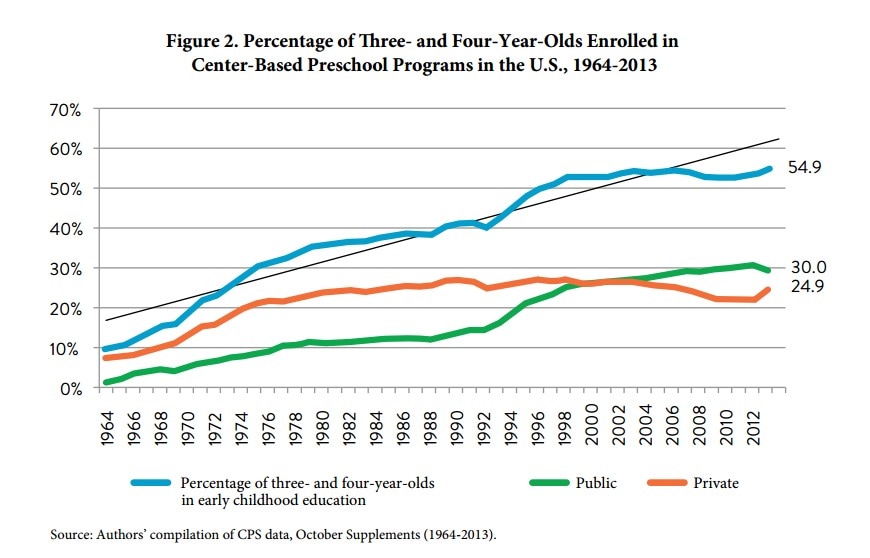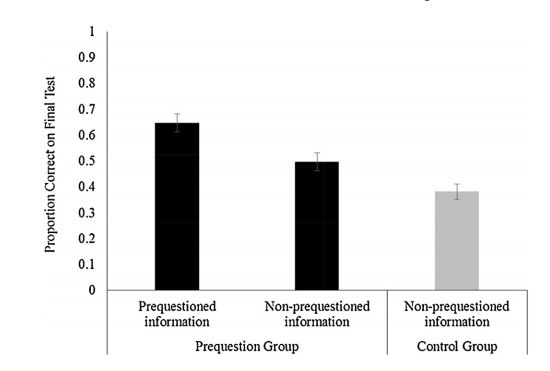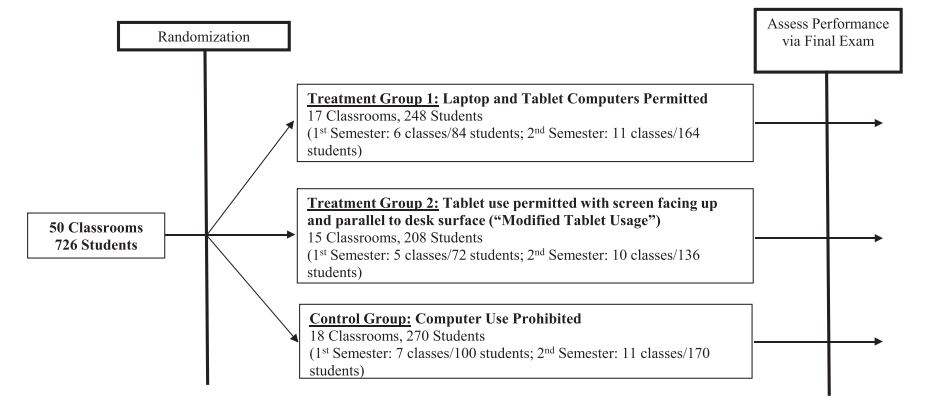That’s not an easy research question. It’s hard to track children in future years as their families move, it’s more difficult to construct reliable assessments for younger children, and there’s less agreement about what constitutes successful outcomes in pre-k than in higher grades.
Perhaps most troubling, it’s not obvious what the counterfactual is; in other words, you’d like to compare the outcome for a child if he goes to pre-k compared to the outcome for the same child if he doesn’t go to pre-k. That’s obviously impossible, so you’ll compare the child to another child who doesn’t go to pre-k….but what does that child do? Fifty years ago it was a good bet that “didn’t go to pre-k” meant the child was at home with his mother. Today, he might go to a home daycare, or be cared for by a relative. To what we should compare pre-k just isn’t so obvious.
In addition, the answers to these questions are clouded by political factors. Ones assessment of the efficacy of public pre-k programs has the potential to be influenced by one’s preconceptions of the efficacy of government programs more generally, and by preconceptions as to whether such programs ought to be within the role of government, whatever their efficacy.
Some researchers have countered the latter set of concerns by noting that effective pre-k programs can more than pay for themselves; children who attend effective pre-k programs will be less likely to drop out of school, more likely to end up in high paying jobs (and so pay more taxes), are less likely to be incarcerated, to need public assistance, and so on. Some researchers claim that pre-k programs return ten dollars or more for each dollar spent.
The pressing questions are: (1) are these claims accurate; (2) what are the characteristics of a “high quality” pre-k program; (3) can governments create and sustain pre-k programs with these features at scale?
Two groups of researchers recognized the need to bring together existing research and to provide policymakers with some answers that are, insofar as is possible, objective and devoid of political ax-grinding. This academic world is small enough that it was inevitable that each should learn about the other, and they chose to join forces. The result is a report, The Current State of Scientific Knowledge on Pre-Kindergarten Effects.
The heart of the report is a consensus statement. I offer four key conclusions from that statement here, verbatim, in red, with brief comments of my own after each conclusion.
Studies of different groups of preschoolers often find greater improvement in learning at the end of the pre-k year for economically disadvantaged children and dual language learners than for more advantaged and English-proficient children.
That’s the counterfactual at work. Rich and poor kids would have different experiences if they were not in pre-k, with poor kids having fewer opportunities for an enriching environment than the wealthy kids.
Pre-k programs are not all equally effective. Several effectiveness factors may be at work in the most successful programs. One such factor supporting early learning is a well implemented, evidence-based curriculum. Coaching for teachers, as well as efforts to promote orderly but active classrooms, may also be helpful.
This is not a surprise…the curriculum matters, and providing training and direction to teachers helps. In the details of the report, curricular comparisons are pretty rough-cut: whole-child vs. skills-based (i.e., math, literacy or both). Whole-child curricula have not been successful in developing literacy, math, or socio-emotional skills…but it also sounds like a bit of a basket category.
Children’s early learning trajectories depend on the quality of their learning experiences not only before and during their pre-k year, but also following the pre-k year. Classroom experiences early in elementary school can serve as charging stations for sustaining and amplifying pre-k learning gains. One good bet for powering up later learning is elementary school classrooms that provide individualization and differentiation in instructional content and strategies.
This is one of the most important points. It’s saying that the oft-cited Perry and Abcederian preschool results are atypical. Absent continued intervention, you should expect fadeout of the pre-k benefit. I’ve blogged about relevant studies before, but the main point is intuitive. Academic and social outcomes are a product not just of school experiences, but also of home and other out-of-school experiences. If those out-of-school experiences are not especially enriching, children benefit (to a greater or lesser degree) from substituting pre-k experiences. The out-of-school experiences continue to matter after pre-k.
When you spell it out, the counter-assumption sounds a little strange: children may be behind their peers in important knowledge and skills by age four, but with a good year or two of pre-k they catch up, and can keep pace with their wealthier peers thereafter. This assumption makes sense if you ascribe an outsize importance to the first few years of development, e.g., as Freud did. But that assumption isn’t right. Outside-of-school experiences continue to matter after age six.
Convincing evidence shows that children attending a diverse array of state and school district pre-k programs are more ready for school at the end of their pre-k year than children who do not attend pre-k. Improvements in academic areas such as literacy and numeracy are most common; the smaller number of studies of social-emotional and self-regulatory development generally show more modest improvements in those areas.
There’s more than one way to do this sucessfully, and the public sector can get it right. There are probably three reasons (at least) that evidence is better for literacy and numeracy than for socio-emotional learning. First, we know better how to teach numbers and letters because we’ve been at it longer. Second, there’s less happening at home that might conflict with the learning happening at school when it comes to these skills. Third, the relative contributions of environment vs. heritable factors (e.g., temperament) is probably larger for literacy and numeracy.
- How can scale-up be improved? (Training and monitoring at a level of detail similar to that used during initial design.)
- Is the economic return really 10 dollars or more, per dollar spent? (That figure may apply to small scale programs operating in the 1960’s. Today, with a scaled up program expect more like 2-4 dollars per dollar spent).
- Should pre-k be targeted or universal? (It depends on the circumstances in the state or district—both are effective).





 RSS Feed
RSS Feed